Peter Konidaris: Pandemic highlights Melbourne’s suburb inequality
Covid’s silver lining is that homes further afield are now more desirable, but Melbourne’s fast-growing outer-suburban corridors are less liveable.

Opinion
Don't miss out on the headlines from Opinion. Followed categories will be added to My News.
Covid-19 has turned life in Melbourne upside down.
But if there was ever a silver lining, this city was always going to find it.
Businesses learnt to pivot, families found fun at home, restaurant goers became stay-at-home chefs, parents became teachers, zoom catch-ups became our social life.
It hasn’t been easy, but if Covid-19 was our great challenge – we’ve met it head-on.
Every year, we unpack the DNA of Melbourne’s postcodes to determine where liveability is highest – and where there’s work to do.
The 2021 results are stark. While we’ve all become used to the common catchcry – we’re all in it together – Covid-19 has, in fact, impacted some communities more than others.
As we begin our recovery, we have an opportunity not just to rediscover everything great about Melbourne, but make it even better – better for everyone.
But first, we must face up to some uncomfortable truths: in some communities, Covid-19 has made the hard even harder, while in others, it’s meant some welcome developments when it comes to flexibility and balance.
Now, governments, businesses and communities must work to bridge that divide.
Our deep-dive analysis of Melbourne’s suburbs and towns is an annual fixture, but this year’s version is the most important yet.

Because it demonstrates not just what’s great – and not so great – about our postcodes, but also where our challenges lie as we come to terms with the ways life has changed.
While not much is certain during a pandemic, it’s broadly accepted that for some, the sudden shift to remote work has, in fact, been a welcome development – one many Victorians will continue to embrace.
It’s a tick for flexibility, but what does it mean for the CBD? For property prices? For transport connectivity? It’s a force of disruption we didn’t see coming, but we have to get right.
Our analysis shows this shift away from a full-time daily commute will impact the liveability of our suburbs. While the exclusive inner-ring remains highly sought after, destinations further afield are catching up.
The commute to the city no longer dominates how we feel about where we live. Instead, larger homes, more affordable real estate and access to open space and parklands in the middle-ring suburbs becomes more important.
Places like Wantirna, Burwood and Montmorency have rocketed up the charts – it’s not so much the suburbs that have changed, but instead, the shift in what we love about where we live.
Everyone’s account of the pandemic is different – depending on what you do, and where you live.
That’s why this year’s liveability scores differentiate whether locals can or will continue to work flexibly or not. For those whose post-pandemic future involves a daily commute, living close to the CBD instantly becomes more appealing.
We’re bullish about the future of postcode 3000. Our CBD might be under enormous stress, hit hard by stay-at-home restrictions, but while others might surmise the death of central business districts, we’re much more optimistic.
The CBD’s not dead, but it will emerge through Covid-19 looking very different. Imagine a renewed economic powerhouse, with a new wave of businesses and entrepreneurs once priced out the market making the most of more modest commercial rental rates.

The CBD and its tenants will need to make the commute worthwhile for staff who have the option of staying at home – the opportunities are endless.
Despite Covid-19, one thing in Melbourne remains the same: our fast-growing outer-suburban corridors are less liveable, despite their populations skyrocketing.
Major infrastructure projects such as the West Gate Tunnel or Suburban Rail Loop will help, but they are only part of the solution. Could we rely on the rise of “mini CBDs” dotted across Melbourne, with the job opportunities these outer communities need, closer to home? Could innovative modes of transport connectivity help overcome the tyranny of distance?
Our healthcare and higher education sectors have opportunities to embrace the new world, too – a digitised way of bringing more patients, students and workers together, no matter where they’re based.
When it comes to liveability, all roads have led to Melbourne for many decades, but it’s a mantle we now have to fight to win back. By making Melbourne equally liveable for everyone, no matter their postcode, we’ll be doing just that.
We must also draw on the strengths that make Melbourne high on the list of travellers and migrants worldwide – a thriving sports and arts culture, a proudly multicultural society, our lively cosmopolitan offerings and our world-class coffee.
As Melbourne embarks on its long road to recovery, it’s a handy recipe for success, but as we begin this journey, we must ensure every Melburnian is along for the ride.
Peter Konidaris is managing partner for PwC Melbourne




